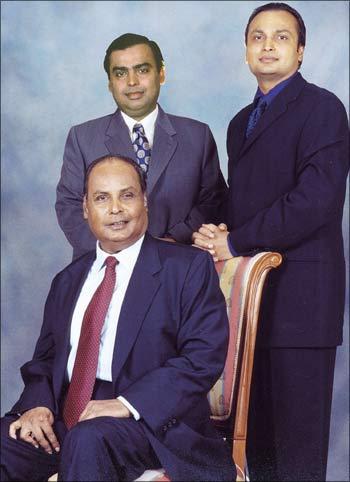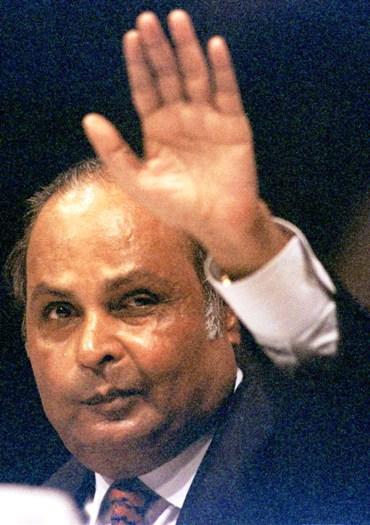 | « Back to article | Print this article |
Why Dhirubhai is the biggest role model for Indian youth
He may have died eight years ago, but (Reliance Industries founder) Dhirubhai Ambani is the biggest role model for the Indian youth.
His journey from rags to untold riches has fired millions of dreams. The common man thinks of him as 'one of us' -- a homegrown genius who became a legend in his own lifetime.
"If Ambani could do it," ask any young, dreamy-eyed man on the street and he will say, "why can't I?" Businessmen are no longer ashamed to say that Ambani is their idol.
His faith in large-scale operations, his ability to spot opportunities in situations that look impossible, makes him the most daring Indian businessman of all times. What others took ages to build, Ambani accomplished in a few short years.
Click NEXT to read on . . .
Why Dhirubhai is the biggest role model for Indian youth
Yet, there is so little about Ambani in the public domain. The first glimpse of his world came in 1996 when Gita Piramal wrote Business Maharajas (Penguin). But he had to share real estate with Rahul Bajaj, Aditya Birla, R P Goenka, B M Khaitan, Bharat and Vijay Shah, and Ratan Tata.
A book solely on Ambani had to wait for a few years when Hamish McDonald wrote The Polyester Prince.
Now, McDonald has come out with a new book called Ambani & Sons (Roli). It captures events that happened after the patriarch's death -- the tussle between his two sons, Mukesh and Anil.
Ambani's detractors, and there are quite a few of them around, say his genius lay in working the system. That was the Licence Raj, and enormous power was vested in the hands of bureaucrats and their political masters.
Click NEXT to read on . . .
Why Dhirubhai is the biggest role model for Indian youth
Anybody with the right connections could get the right licence, and ensure that rivals got starved to death. The evidence is at best circumstantial. But McDonald has documented it well in his latest book. The conclusion is best left to the reader's imagination.
It is also strange that Ambani alone is seen as having used the Licence Raj to his advantage. This was a game everybody in that day and age played.
Enquiries initiated by the government showed that leading business families like the Birlas and Tatas had pre-empted industrial licences to create shortages in the marketplace. Somehow, the mark has stuck to Ambani alone.
One thing is for sure, Ambani was a great relationships man. He had an elephantine memory and could recollect names and faces from the distant past. This gift served him well in business.
Click NEXT to read on . . .
Why Dhirubhai is the biggest role model for Indian youth
And he had guts. Even when he was a little-known trader, rivals once spread the rumour that he had gone bankrupt. Instead of losing sleep over it, Ambani out up a public notice that whoever owed him money could take it from him there and then.
He was hard up for cash, but the gesture improved his stature manifold. The same trait was seen several years later when a bear cartel hammered the Reliance stock. He bought the stock and at the right time demanded delivery. The cartel was almost wiped out.
McDonald mentions an interesting incident. Doctors, when Ambani was on his deathbed, believed that he would choose a Saturday to die. This is because the funeral would then be held on Sunday.
As offices would be closed, people would be able to attend it in large numbers, and nobody would be inconvenienced. Indeed, Ambani died on Saturday.
Click NEXT to read on . . .
Why Dhirubhai is the biggest role model for Indian youth
But there was more to Ambani than just manipulation. He could think out of the box and was generally ahead of the curve.
When his older son, Mukesh, went to seek his advice for the mobile telephony business, Ambani told him that only if he can reduce the price of a phone call below a postcard can he think of succeeding.
He was the man who started the equity cult in the country. The annual general meeting of the shareholders of Reliance was often held in a football stadium. People travelled long distances just to hear their leader speak. McDonald's book gives a good view of the Ambani world.





